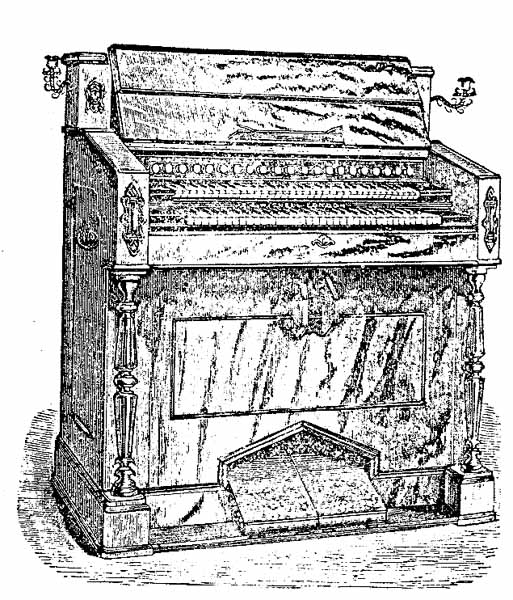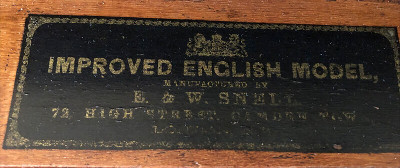 | Reed Organs in EnglandA comprehensive study of reed organsin England, Scotland and Wales. |
|
Next: The University Organ Previous: J.W. Sawyer (1885-1952) |
Edward (b.1840) and William (b.1841) Snell made the Albany Organ and were in business from at least 1864 until they finally closed in 1907. Addresses included: 402A Essex Road, Ball's Pond, N. London in 1964; 19 Church Terrace, Kentish Town; 23A King St. North, Camden Town, London 1883; 3 Collonade Buildings, Holloway Road, London in 1884; Ledbury Road, Bayswater in 1887 and others. Established in 1864 and known as Ed. Snell and Co. at 45 Essex Road, Islington in 1898 and later in that year as Snell Bros. at 383 Hornsey Road, London. Also shown at 305 Hornsey Road, Seven Sisters Road in 1900; at Nightingale Works, Hornsey Road in 1902 at Seven Sisters Road, London in 1903 and at 100 Blackstock Road, Finsbury Park in 1904.
In 1864, 1866, 1872 and 1874 they advertised as follows.
E. & W. SNELL'S DRAWING-ROOM MODEL.
These instruments, for sweetness of tone, rapidity of articulation,
and general excellence, are pronounced by the Profession the best yet
manufactured. In elegant walnut. Three stops, 5 octaves; 8
guineas.
There was also a less expensive school model.
E. AND W. SNELL'S IMPROVED HARMONIUMS.
For tone, touch, rapidity of articulation, and
general excellence, pronounced by the profession the best manufac-
tured. Prices from 5 guineas. Lists, containing full description
(including their newly invented stop, the Tirasse tenuto), free on
application to E. and W. Snell, 19, Church-terrace, Kentish-town-
road, N.W. Manufactory, Little King-street North, Camden-town.
London. Tuning and repairs. Trade supplied
E. & W. SNELL'S IMPROVED HARMONIUMS.
For tone, touch, articulation, and general excellence, are pronounced
by the profession and public the best and cheapest
manufactured. Price lists, with full description, free of E. &
W. Snell, 37 Kelly-street (re-named), Kentish-town, London, N.W.,
manufactury at Little King-street-north. Trade supplied. Pedal
Harmoniums on Organ Principles.
In Musical Times 1/9/1877:
E. & W. SNELL'S
IMPROVED ENGLISH HARMONIUMS.
MANUFACTORY: LITTLE KING STREET NORTH, CAMDEN TOWN, LONDON, N.W.
Chief characteristics of the "SNELL HARMONIUM". Pure, musical and
euphonious quality of tone, posessing great sweetness and organ like
character, combined with perfect articulation and quality of sound
throughout the scale, the tenor notes not predominating over the
treble. Light and elastic touch, rendering the instrument equally
effective for Secular as for Sacred music. Simplicity and novelty of
action. Improved mechanism and superior finish throughout. Durability,
general excellence, and extreme moderation of price. Full particulars,
designs, and prices, with testimonials specially referring to the
important improvements introduced into these much admired instruments,
free of the makers, E. and W. Snell, as above. Profession and trade
supplied.
E. and W. SNELL beg to announce that, having just completed the
Enlargement of their Premises, they are now enabled to execute any
orders with which they may be favoured with promptitude and
despatch. Any kind of instrument of the free reed class to order.
And in Musical Times 1/12/1880:
The "SNELL" Harmonium is the most perfect Reed Instrument ever made, combining all the characteristics of modern Organ manufacture with a low price. Wide testimonials from Lord Bishop of Colombo, etc. Send for price lists to E. & W. Snell, Pedal Reed Organ Builders, King Street North, Camden Town, London NW. Reed Organs built to any speicification. Special terms to trade and professionals.
Edward and William's father was Robert Snell (b.1802-d.1880) who built seraphines from 1825 onwards, see Chapter 3.32. He built a 24 note per octave enharmonic seraphine c.1851, see Chapter 28.
Robert and his family lived at 37 Kelly Street, St. Pancras. His wife was Martha who was by the 1881 census a widow living with her sons and a servant. Robert had been active in the business since 1825. Both sons were listed as making and tuning harmoniums.
Among other things, Edward [Robert?] Snell held patents for several improvements to harmoniums. One of these was for the ``pedal point'' feature in 1861. This was also called ``tirasse tenuto'' and was somewhat similar to the ``prolongement'' of Alexandre and Mustel. It enabled a device to hold down the bottom key of chords in the lower register giving a pedal substitute effect.
In 1884 they moved to more commodious premises in Holloway Road and the firm was known as Snell and Snell Co.
In 1898 Ed. Snell and Co. were making the ``Lieblich'' and ``College'' pedal reed organs. They would also make 3-manual organs to special order.
In 1907 a customer bought a 2MP organ from the Snell brothers. By that time they were quite elderly and he was told that it was the last reed organ they would make. The business ceased soon afterwards.
Their instruments had the reputation of being well made, with rapid articulation and a tone like a pipe organ.
It was noted in Musical Opinion 1937: We are glad again to see the name of Snell mentioned in association with reed organs. We have some remembrance of the two brothers, E. and W. making reed organs, mostly to order, in various places in North London; in fact, they were like Schudi, the harpsichord maker, who is said never to have finished an instrument until the one previously made was sold. They were preceded as makers by their father, who applied the device known as ``tirasse tenuto'' (or holding bass note) to some of his organs before it was adopted by Alexandre and his imitators in the USA.
R. Snell Opus 1276
This is a 25-note miniature harmonium that I acquired in Apr'2022 from R. Moon in Devon.
Pictures show various views of cleaning and re-assembly of the major components back in the case. Cleverly everything drops in from the top with leather straps to hold from the sides. The single feeder is hand operated by a lever under the LH side.
Curiously, inside is a pasted label obviously cut out from a contemporary newspaper:
... Mr. Robert Snell, Jnr, in 6,000 Shares, at 2s.6d. each. Each one will entitle the Holder to one Portrait of himself or any Friend, and one chance in the Distribution of Musical Instruments of the value of £300. List of the Prizes: 1. The BICHROMATIC SERAPHINE, from the Great Exhibition of 1851, Class 10, No. 528 -- 80 guineas 2. Self acting Organ, by Weeks, plays sixty tunes, in elegant bookcase, \&c, surmounted by an eight-day striking clock -- 70 guineas 3. Chordaeolian uniting the Cottage Piano-forte and Harmonium -- 40 guineas 4. Finger Organ, four octaves, from FF, two stops, swll, \&c -- 24 guineas. ... -- 15 guineas
Unfortunately there is no date and the rest of the label is missing.
Incidentally, similar Weeks barrel pipe organs from prior to 1834 are known, for instance this example at Raby Castle: https://www.acpilmer.com/thomas-weeks-cabinet-at-raby-castle.
There is a signature inside the reservoir which appears to read ``W. Snell'', also the hand made keyboard is stamped W.S. 1276. All parts of the organ carry the pencil mark 1276. It could be an apprentice piece, but I have to say is rather crudely made.
The reference above to portraiture and the effort to raise cash for R. Snell would suggest a date just prior to bankruptcy in 1865, see Chapter 3.32. Clearly Snell was trying many ideas, but the early business was not sucessful.
RFG-2675 2M
A drawing of a 2M Snell harmonium is shown in Robert Gellerman's database no.2675.

ROS-3605 1M
One with a wallnut case, said to be from around 1867 is in ROS DB no.3605. Stops Sourdine 5, Bassoon 4, Cor Anglais 1, Grand Jeu 9, Expression, Flute 1, Hautbois 4, Sourdine 5.


The Snells built a number of larger reed organs of which some examples are listed below. It is said that these were done mostly to order, and that they usually did not finish an instrument until the previous one was sold.
2MP c.1908
Advertised in The United Methodist 19/3/1908 was a 2MP American organ by Snell for the price of 40 guineas reduced from 60. The shop was James G. Stagg and Sons, Red Lion Street, Holborn.
Gill Eyers' Snell or Imperial 2MP/8
This instrument carries a Snell Brothers, London name plate. It was purchased by Mr. Eyers, Gill's father, from the Imperial Organ and Piano Company Ltd., Hackney, in 1935. Gill noted that the original receipt is still with the organ.
I am now wondering if this is a very early Imperial organ, or actually built by the Snell Brothers. The latter seems possible as there was little overlap between the two companies and I believe it may have been a re-conditioned earlier instrument.
2x 61-note manuals of CC-c''' compass 18-note pedalboard Swell: Great: Viola 4' Diapason 8' Gamba 8' Dulciana 8' Tremolo Clarinet 16' Voix Celeste 8' Flute 4' Bourdon 16' Swell to Great Bourdon Pedals 16' Super Octave Coupler Great to Pedal Swell to Pedal electric blower

Albert Halls 2MP/12
Albert Halls of Brentwood wrote a letter to the editor of Musical Opinion in Jan'1937 [109] in which he notes the compact size of his 2MP Snell reed organ. He said it was obtained re-built as new for 50 guineas and was slightly narrower and only 1/2'' deeper than his piano. To achieve this Snells had used sticker action for the Swell manual pushing up the pallets above. Sets of reeds were arranged in three pairs, one above the other and each having its own swell shutter. The Great action was of the conventional American organ type.
Swell: Great: Bourdon 16' Double Diapason 16' Gedackt 8' Diapason 8' Gamba 8' Dulciana 8' Voix Celeste 8' Viol d'Amour 8' Principal 4' Octave 4' Fifteenth 2' Tremulant Couplers: Pedal: Swell to Great Open Bass 16' Swell to Pedal Bourdon 16' (derived) Great to Pedal two composition pedals to Swell and Great lever action swell pedal Rockingham blower with 1/4~HP motor
Halls noted that the build up is excellent and the full Swell (6 ranks) quite thrilling. The Pedal bass also comes through clearly and has prompt speech. The Great Octave is very bright.
e-Bay *5893
A small harmonium in very modern style appeared for sale in Stockton-on-Tees in Oct'2023. It is said to be in very good working condition.
The label carries wording as follows:
IMPROVED ENGLISH MODEL Manufactured by E. \& W. Snell 72 High Street, London, NW

Rob Allan